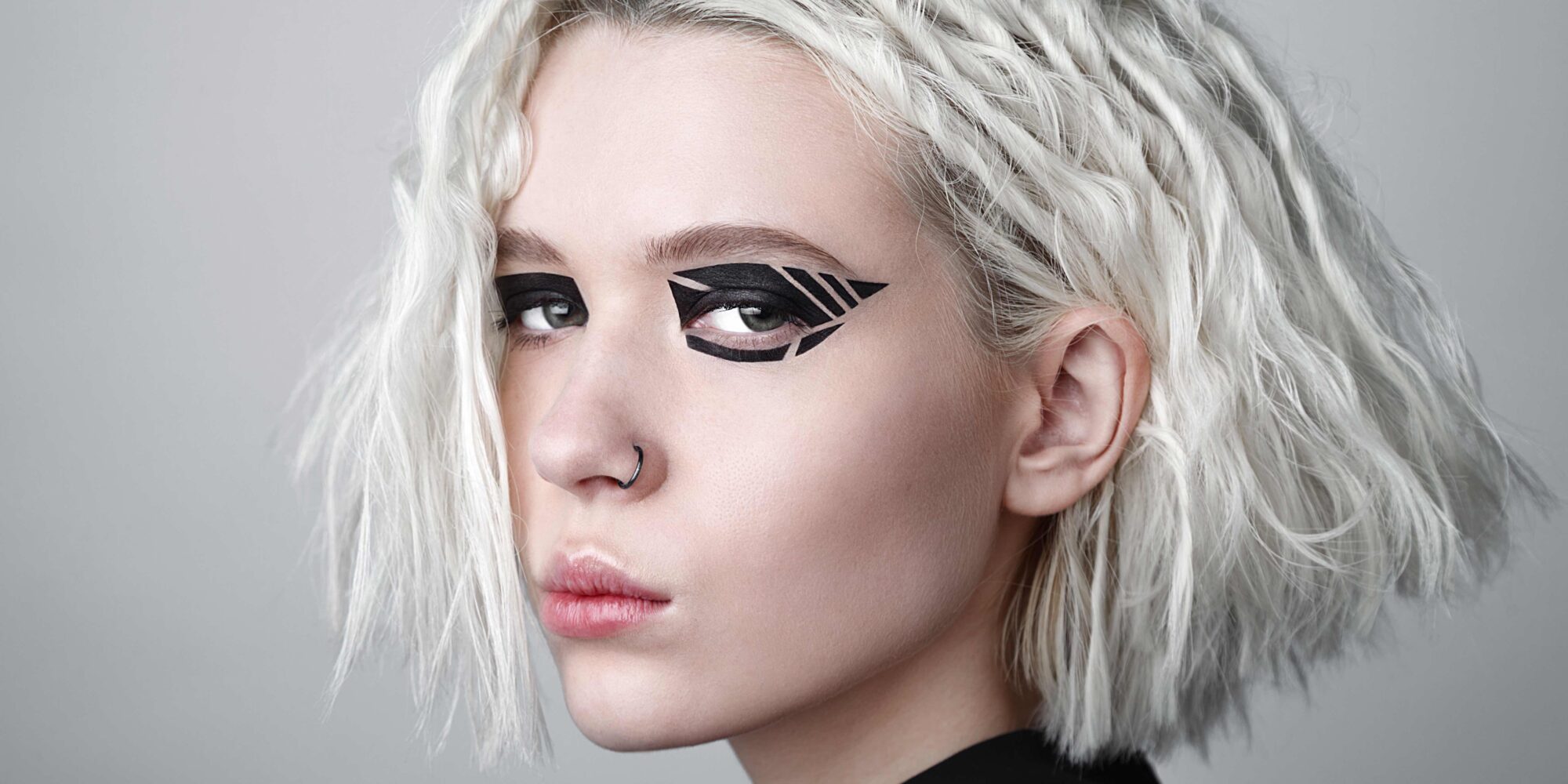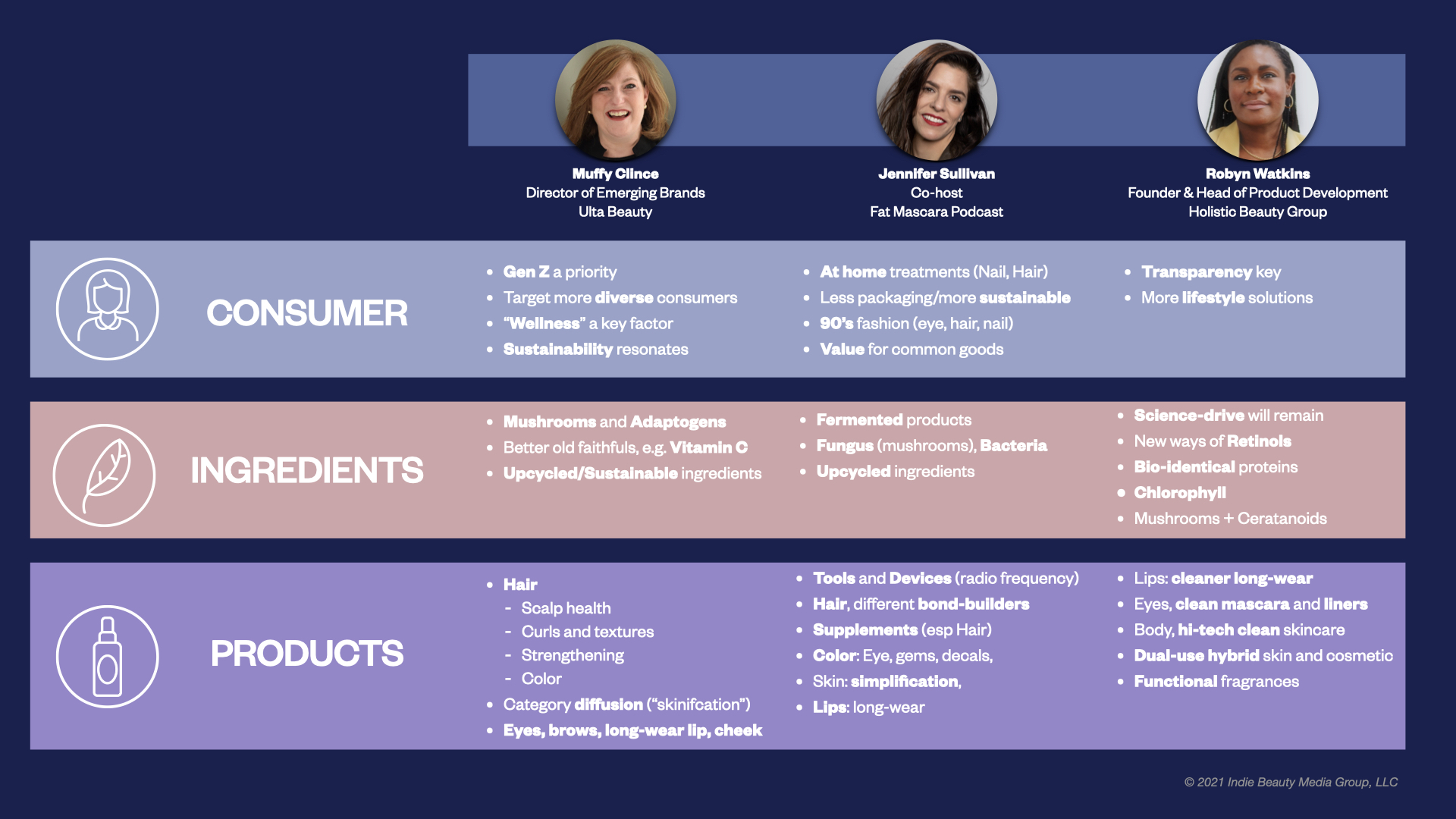
Ulta Beauty’s Muffy Clince, Fat Mascara’s Jennifer Sullivan And Holistic Beauty Group’s Robyn Watkins On Beauty Trends Set To Reign In 2022
The beauty industry bounced back this year as people began to realize pandemic conditions are a lasting feature of modern existence rather than a momentary blip. But how different will 2022 look? Current beauty trends are expected to accelerate as new innovations take root in formulations and packaging, but emerging categories are around the corner, too.
For last Wednesday’s episode of Beauty Independent’s webinar series In Conversation, Muffy Clince, director of emerging brands at retailer Ulta Beauty, Jennifer Sullivan, co-host of podcast Fat Mascara, and Robyn Watkins, founder of boutique product development consultancy Holistic Beauty Group, shared their thoughts on the direction of beauty in 2022, including products and ingredients they’re bullish on for the months ahead.
Consumer Trends
Economic uncertainty has caused shoppers to hone in on value. Brands selling essentials with no discernible value proposition should be cautious about wading into premium price points, particularly as consumers become more educated on formulations and demanding about pricing and ingredient transparency. “You have to make it worth it. I’ve seen a lot of backlash online where, if something is expensive and it’s the kind of thing that you can find elsewhere, consumers love coming up with a dupe,” said Sullivan, emphasizing, “There’s no reason for you to be pricing well above the cost of goods.”
Sullivan, who served as beauty director and features editor at Marie Claire for seven years, predicts there will be a continued willingness on the part of consumers to shell out for devices addressing hair thinning and acne as the resonance of at-home beauty treatments isn’t dwindling. “It gave some power back to consumers realizing they have the products and skill set to do some of these professional beauty services themselves,” said Sullivan, pointing to gel manicures, hair color and dermaplaning tools as additional elements of consumers’ at-home beauty practices.
The centrality of gen Z consumers isn’t disappearing, and Ulta plans on intensifying efforts serving its diverse customer base. The retailer committed $25 million this year to support BIPOC-owned businesses and brought on 13 brands. Clince explained the goal is to make every Ulta shopper feel represented across prices and categories. While consumer sentiment has remained consistent on clean, vegan and cruelty-free claims, Ulta’s consumer insights show interest in sustainability surging. In tandem with efficacy, the expectation is that sustainability will become a major purchasing driver moving forward, especially for gen Z shoppers.
Beauty’s extension into wellness and lifestyle isn’t dissipating. According to an Ulta survey, 65% of its guests connect wellness with beauty. The retailer rolled out 450 in-store wellness shops in 2021 and is set to expand the concept in 2022. Ingestibles and feminine hygiene are wellness niches the retailer anticipates flourishing. Brands are stepping back from creating multistep topical skincare routines and developing a host of lifestyle solutions that work together. Watkins said, “They might have a two-step skincare with a tincture, and we might be seeing other types of forms of skincare like transdermal patches.”

Ingredient TRENDS
Watkins said brands are determined to ensure their products fuel results in order to nab positive customer reviews and motivate healthy repurchase rates. They’re prioritizing difference-making hero ingredients and clinical studies to verify their claims. “We’re seeing that brands are shying away from fairy dusting,” she said.
Watkins foresees a new wave of retinol alternatives rising through the ranks that promise to resurface and exfoliate the skin as well as a rise in carotenoids. “[People] are getting comfortable with things that used to weird out a beauty customer,” said Sullivan, who spoke to excitement around prebiotics and postbiotics, fermented purple rice and fungi as star ingredients. Watkins also cited bioidentical proteins for ingredients like collagen or elastin, which have been challenging to source ethically, will increasingly enter formulators’ playbooks.
As sustainability becomes table stakes in beauty, brands are turning to upcycled ingredients such as coffee grounds, fruit stones and chai spices that give a second life to byproducts of agricultural or commercial practices. LOLI Beauty’s Date Nut Brûlée nourishing balm is a product incorporating upcycled ingredients that’s been popular with shoppers at Ulta.
Category Trends
Ulta’s CEO Dave Kimbell projects big sales for color cosmetics in 2022. Specifically, the retailer is betting on brow products, cream cheek items, stick makeup formats and multiuse offerings. Makeup looks are transitioning from no makeup makeup into a bolder territory for the younger set. Gen Z consumers are embracing graphic eyeliner, colored brows, 1990s-inspired pastel eyeshadows, gemstones and decals.
Skincare routines are getting pared down. “I don’t see that 10-step routine sticking around,” said Sullivan. She elaborated, “I’ve heard that from a lot of people that they’re simplifying when it comes to their beauty regimens.” Skincare, however, is bleeding into an array of categories. The skinification of hair remains a prominent movement, and skincare benefits are being weaved into makeup. The blurring of category lines makes the case for fewer, more effective products across categories.
As the Omicron variant stokes fresh pandemic fears, masks are likely to stay put. Long-wear lipstick options have benefited from masking. Their drying, hard-to-remove formulas are being improved. “We’re seeing a lot of requests around making these formulas cleaner and sustainable,” said Watkins. Dermal fillers and procedures like the “lip flip” where Botox injections are placed in the upper lip to relax the muscles and “flip” the lip upward are pushing beauty shoppers to pout products that prep and plump the mouth.
Haircare was a standout category in 2021. At Ulta, Clince mentioned styling products and heatless tools, and scalp health and hair growth formulas have been strong. Dyson’s hair implements are hot holiday sellers, but Clince suggests interest in them will slow down in the coming year. Sullivan expects to see consumers flocking to various versions of bond builders like K18’s mask designed to reverse hair damage in minutes.
To watch a replay of the webinar on 2022 beauty trends, visit Beauty Independent’s premium In Conversation webinar library.




